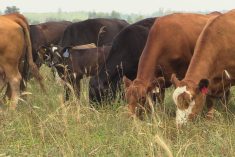It’s that time of year when the feeder cattle market experiences a calm before the storm. The fall run will get underway over the next three weeks and recent market activity appears to be quite positive. Last week, yearlings and calves traded $3 on either side of unchanged compared to seven days earlier. However, larger packages of higher quality yearlings were steady to $3 higher.
There are a few pockets in Alberta and Saskatchewan that are struggling with dryer conditions. This has brought on some yearlings sooner than anticipated but calf numbers are very thin. Feedlot margins are hovering around breakeven and we’ve seen equity buildup over the past month. Looking forward, the April live cattle futures experienced a contract high close on Friday which has bolstered demand for 850 pound plus feeders.
Read Also

U.S. grains: CBOT soybeans, corn, wheat fall in USDA data aftermath
Chicago grains took a dive on Friday, following a closely watched U.S. government crop report and the release of export data that could provide clues into Chinese buying.
In Central Alberta, mixed steers averaging 900 pounds traded from $196 to as high as $201; mixed heifers averaging 875 to 900 pounds were quoted from $180 to $183 in the same region. A small group of medium to larger frame tan steers weighing 825 pounds were quoted at $210 landed in Southern Alberta; red heifers weighing 800 pounds were reported at $189 in the same region. In southcentral Saskatchewan, angus-based mixed steers weighing 675 pounds were valued at $222 while similar quality heifers weighing 606 pounds were quoted at $215.
A grain industry led crop tour estimated barley yields at 71.1 bushels per acre compared to 69.4 bushels per acre last year. Canadian barley production is now estimated at 9.1 million mt, compared to the 2017 output of 7.9 million mt. Cattle producers are expecting Fridays’ USDA WASDE report to show a downward revision in fourth quarter beef production. These two factors are contributing the strength in the nearby feeder market.
Canadian feeder cattle exports to the U.S. for the week ending July 21 were 138,092 head, up from 83,009 head for the same time last year. Strong demand from south of the border will continue to support Western Canadian feeder prices, especially for yearlings.















